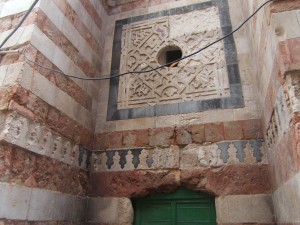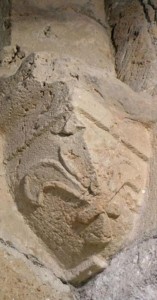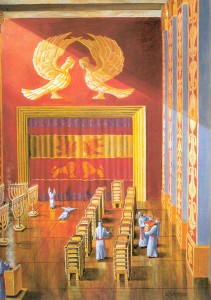The country is currently a hive of activity. It doesn’t matter where you are geographically there is some excitement going on. From music, dance and food festivals, to wine, beer, art and theatre extravaganzas, Israel is buzzing with energy. Even nature is attuned to all the action with juicy clusters of grapes dangling from the vines and succulent passion fruit, pomegranates and mangoes at their peak. The streets are filled with holiday-makers and restaurants and cafes are overflowing onto the pavements.
This is Israel at its best, vibrant and colourful, passionate and noisy, focused on relaxation and fun. In fact, throughout its history this land has never been a dull place, there has always been action of some kind going on. Sometimes it has not been of our choosing and many times it has involved blood and guts and gore, but it was never boring. Often, when taking tourists around the country, I have to impress upon them that they should not view the remains of our history in the monochrome colours they see today.
The earliest references to colour come in the book of Exodus when G-d enumerates to Moses the donations he should receive from the people in order to build the tabernacle in the desert and make the priestly garments: “And these are the gifts you shall accept from them: gold, silver and copper; blue, purple and crimson yarns, fine linen, goats’ hair; tanned ram skins…lapis lazuli and other stones..” Exodus 25 (iii-vii).
Later on, in the book of Kings, we read about King Solomon’s temple in Jerusalem and the marble and gold and colourful materials he used to make this glorious structure. The Second Temple was apparently also an exquisite edifice, so much so, that the sages of Israel recorded in tractate Sukka 51b of the Babylonian Talmud: “Whoever has not seen the Holy Temple built by King Herod, has never in his entire life seen a beautiful building”.
As different cultures occupied the land they brought with them their own unique artistic contribution, and, with a little bit of imagination it is not too difficult to reconstruct what might have been. If, for example, we take the well known sites of Masada, Caesarea and Jerusalem’s Old City, present day visitors are wowed by the views and archeological remains. But when wandering through those remains of times long gone, it is important to remember that life was no less colourful then than it is now.
Each civilization that passed through this land painted its own palette on our landscape. The Romans, flamboyant as they were, had a tremendous sense of aesthetics. Whilst for the most part we are left with brown or grey stones as testament to their architectural prowess, every so often we come across a hint of more. Whether it is in the skillful and colourful mosaics, the few remaining frescoes, or the opus sectile floor tiling, their life was lived in glorious technicolour, using the latest fashionable shades imported from Rome.
In his book “The Jewish War”, the historian Josephus talks about the marble pillars on Masada. Modern archeologists think he was mistaken; there were no real marble columns there. However, there were columns which were plastered and painstakingly decorated to look like the real thing.
Scattered throughout the mountain-top fortress are the remains of wall paintings which have survived largely due to the dry desert climate. These are the best examples in all the country, although we also have evidence of similar decorations in Caesarea on the walls of the hippodrome and in the Herodian Mansions in Jerusalem’s Jewish Quarter, to name but a few. These artworks probably owe their longevity to a technique the Romans used to create these paintings. Known as frescoes, the colours were painted onto the still wet plaster so that they would be better absorbed into the wall and last for longer. We know the Romans who inhabited this land were well acquainted with the trends in Rome and imported them to the Levant. The newest pigments were shipped over so that the local nobility could decorate their homes in the contemporary style like their compatriots in Europe. In Jerusalem we see one particular room was repainted three times in order to keep up with the latest fashion!
 The early Moslems brought with them their own colour scheme which endured throughout the different periods they ruled over the land. It incorporated a lot of greens and blues and largely non-representational imagery and intricate calligraphy. The beauty of this art is evident even from the most cursory look at the exterior of the Dome of the Rock today. During a later period (1260-1517), the Mameluks contributed the attractive red and white ablaq pattern of alternating colours, that is a striking characteristic on the outside of their structures. It has even been incorporated as a feature in many of the country’s modern buildings.
The early Moslems brought with them their own colour scheme which endured throughout the different periods they ruled over the land. It incorporated a lot of greens and blues and largely non-representational imagery and intricate calligraphy. The beauty of this art is evident even from the most cursory look at the exterior of the Dome of the Rock today. During a later period (1260-1517), the Mameluks contributed the attractive red and white ablaq pattern of alternating colours, that is a striking characteristic on the outside of their structures. It has even been incorporated as a feature in many of the country’s modern buildings.
Crusader influence can be seen all over Israel. The years of their rule (1099-1271 in the Holy Land) span two major architectural periods. At first they built in the heavy solid Romanesque tradition, which later gave way to the much more delicate Gothic style. They too plastered the walls of their structures  and created paintings and mosaics which have endured. Unfortunately the colourful stained glass for which they are well known for making into an art form has not survived.
and created paintings and mosaics which have endured. Unfortunately the colourful stained glass for which they are well known for making into an art form has not survived.
One Crusader decoration which we can still view today is in the impressive Crusader complex in Acre. Some believe it is the original depiction of the fleur-de-lis, which went on to become the symbol of the French royal family. In 1148, Louis VII of France visited the city and many preparations were made in advance of his arrival. The refectory of the Knights Hospitaller compound is built with heavy thick Romanesque pillars and walls. However, the king was a fan of the new lighter Gothic style and in honour of his visit the building was converted. That is why when we go there today we see a mixture of light Gothic rib vaulting sitting on heavy three metre thick walls. Perhaps in an attempt to make the walls more attractive they were decorated with carved lilies of the Sharon, a local flower. It seems the French king was so taken with the design he went on to incorporate them in his royal coat of arms.
So next time you find yourself visiting one of the many tels or national heritage sites in Israel, try a new approach. As well as marveling at what you can see, take a few moments to reconstruct what ancient life might have been like. Enjoy the colours, the textures, the noise and smells, of what could have been. Allow the nuances of the distant past to soak in and then let your imagination run riot.

